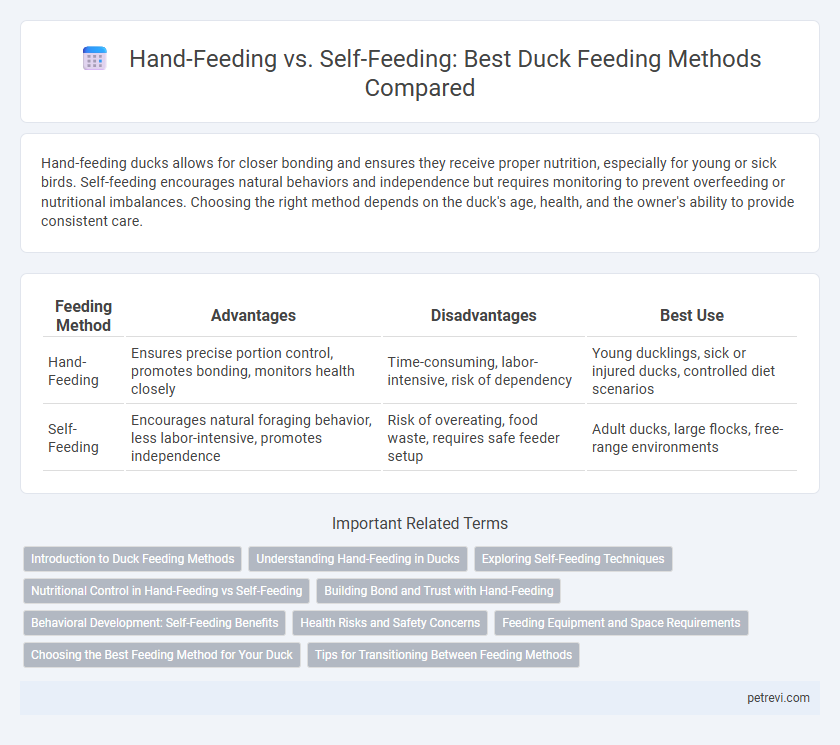Hand-feeding ducks allows for closer bonding and ensures they receive proper nutrition, especially for young or sick birds. Self-feeding encourages natural behaviors and independence but requires monitoring to prevent overfeeding or nutritional imbalances. Choosing the right method depends on the duck's age, health, and the owner's ability to provide consistent care.
Table of Comparison
| Feeding Method | Advantages | Disadvantages | Best Use |
|---|---|---|---|
| Hand-Feeding | Ensures precise portion control, promotes bonding, monitors health closely | Time-consuming, labor-intensive, risk of dependency | Young ducklings, sick or injured ducks, controlled diet scenarios |
| Self-Feeding | Encourages natural foraging behavior, less labor-intensive, promotes independence | Risk of overeating, food waste, requires safe feeder setup | Adult ducks, large flocks, free-range environments |
Introduction to Duck Feeding Methods
Hand-feeding ducks ensures controlled nutrition and helps monitor their health, especially for ducklings or injured birds. Self-feeding encourages natural foraging behavior, promoting physical activity and mental stimulation essential for their development. Choosing the optimal duck feeding method depends on age, health status, and environmental conditions to balance growth and well-being.
Understanding Hand-Feeding in Ducks
Hand-feeding ducks involves directly offering food to encourage bonding and ensure proper nutrition during early development stages. This method allows for close monitoring of intake and health, reducing the risk of malnutrition and promoting tame behavior. Hand-feeding is essential for orphaned or weak ducklings that cannot compete for food independently.
Exploring Self-Feeding Techniques
Self-feeding techniques for ducks promote natural foraging behaviors and enhance their independence by providing access to clean water, balanced pelleted diets, and opportunities for grazing on aquatic plants or insects. Implementing raised feeders and food scatter methods encourages activity and reduces stress, leading to healthier growth and improved digestion. Monitoring feed intake and maintaining consistent feeding schedules optimize nutrition while minimizing waste and contamination risks.
Nutritional Control in Hand-Feeding vs Self-Feeding
Hand-feeding ducks allows precise nutritional control by providing balanced, measured portions tailored to their dietary needs, preventing overfeeding and nutrient deficiencies. In contrast, self-feeding offers less regulation, as ducks may overeat or consume imbalanced feed, risking obesity or malnutrition. Optimal growth and health are better supported through hand-feeding due to controlled intake of essential proteins, vitamins, and minerals.
Building Bond and Trust with Hand-Feeding
Hand-feeding ducks fosters a strong bond and trust between the bird and caretaker by encouraging close interaction and positive reinforcement. This method helps ducks associate humans with safety and food, which can ease handling and training. In contrast, self-feeding promotes independence but may limit opportunities for social bonding essential for tame and cooperative behavior.
Behavioral Development: Self-Feeding Benefits
Self-feeding encourages ducks to develop natural foraging behaviors, enhancing their motor skills and independence from an early age. This method promotes problem-solving abilities and reduces dependency on humans, leading to improved overall well-being and social interaction within the flock. Ducks raised with self-feeding methods exhibit stronger survival instincts and adaptability compared to those hand-fed.
Health Risks and Safety Concerns
Hand-feeding ducks can increase the risk of transmitting diseases such as avian influenza and salmonella due to close human contact and contaminated feeding tools. Self-feeding methods reduce stress and aggressive behavior among ducks, lowering injury risks and promoting natural foraging instincts that enhance their overall health. Proper hygiene and clean feeding environments are essential in both methods to minimize health risks and ensure duck safety.
Feeding Equipment and Space Requirements
Hand-feeding ducks requires minimal equipment, typically just a feeding tray or small container, and allows for controlled food portions, making it suitable for limited spaces. Self-feeding demands larger feeders such as troughs or automatic dispensers, necessitating more space to accommodate multiple ducks feeding simultaneously. Efficient use of space and proper feeder design are crucial in preventing food waste and ensuring all ducks have access to nutrition.
Choosing the Best Feeding Method for Your Duck
Hand-feeding allows precise control over your duck's diet and ensures proper nutrition, especially for young or sick ducks requiring special care. Self-feeding promotes natural foraging behavior and independence, benefiting healthy ducks with access to a balanced diet through quality feed and fresh water. Evaluating your duck's age, health status, and environmental conditions helps determine the best feeding method to support growth and well-being.
Tips for Transitioning Between Feeding Methods
Gradually introducing self-feeding encourages ducks to develop natural foraging behaviors while reducing dependency on hand-feeding. Start by placing food in accessible areas near their usual feeding spots and progressively decrease hand-feeding sessions to promote independence. Ensuring fresh water availability and monitoring their eating habits during this transition supports a smooth adjustment to self-feeding.
Hand-Feeding vs Self-Feeding for Duck Feeding Methods Infographic

 petrevi.com
petrevi.com